MITSUBISHI GRANDIS 2008 Owner's Manual (in English)
Manufacturer: MITSUBISHI, Model Year: 2008, Model line: GRANDIS, Model: MITSUBISHI GRANDIS 2008Pages: 458, PDF Size: 18.52 MB
Page 371 of 458
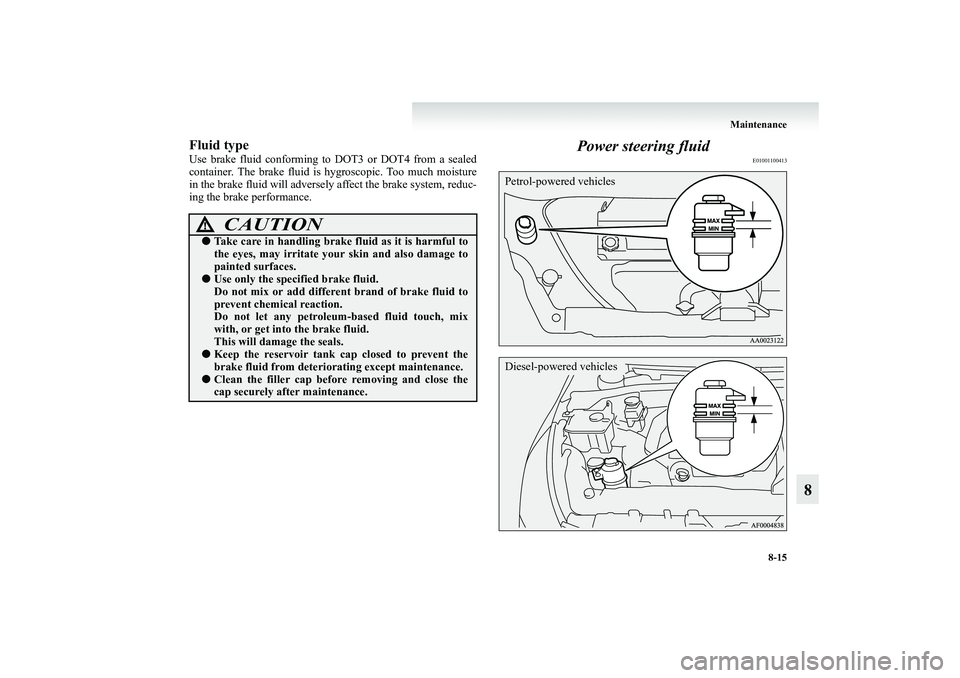
Maintenance
8-15
8
Fluid typeUse brake fluid conforming to DOT3 or DOT4 from a sealed
container. The brake fluid is hygroscopic. Too much moisture
in the brake fluid will adversely affect the brake system, reduc-
ing the brake performance.
Power steering fluid
E01001100413
CAUTION
!●Take care in handling brake fluid as it is harmful to
the eyes, may irritate your skin and also damage to
painted surfaces.●Use only the specified brake fluid.
Do not mix or add different brand of brake fluid to
prevent chemical reaction.
Do not let any petroleum-based fluid touch, mix
with, or get into the brake fluid.
This will damage the seals.●Keep the reservoir tank cap closed to prevent the
brake fluid from deteriorating except maintenance.●Clean the filler cap before removing and close the
cap securely after maintenance.
Petrol-powered vehiclesDiesel-powered vehicles
BK-XP08E1ENUK.en-uk.book Page 15 Monday, August 13, 2007 2:20 PM
Page 372 of 458
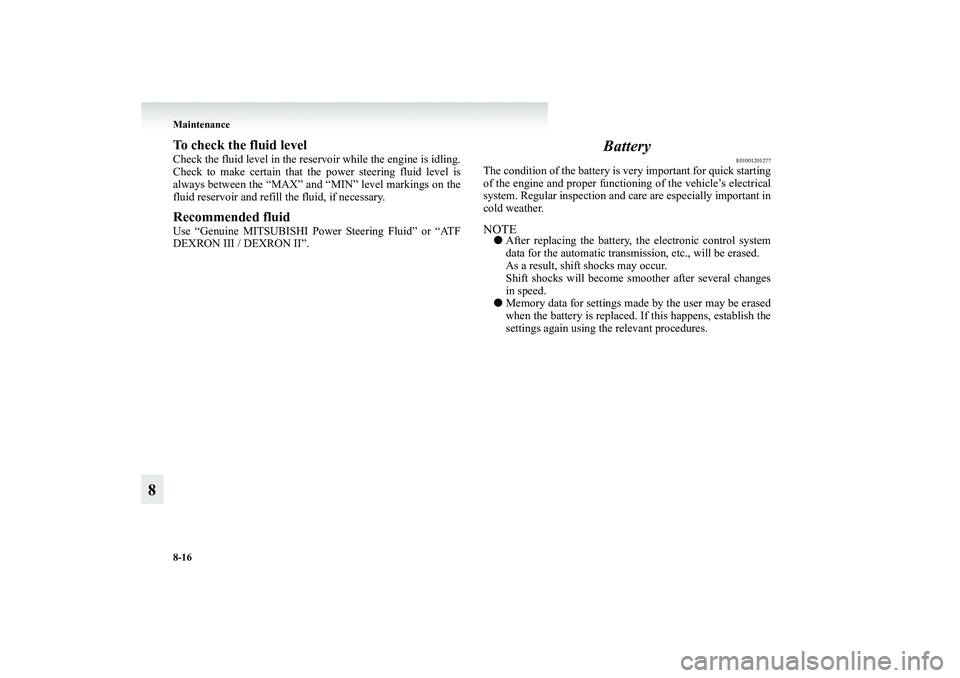
8-16 Maintenance
8
To check the fluid levelCheck the fluid level in the reservoir while the engine is idling.
Check to make certain that the power steering fluid level is
always between the “MAX” and “MIN” level markings on the
fluid reservoir and refill the fluid, if necessary.Recommended fluidUse “Genuine MITSUBISHI Power Steering Fluid” or “ATF
DEXRON III / DEXRON II”.
Battery
E01001201277
The condition of the battery is very important for quick starting
of the engine and proper functioning of the vehicle’s electrical
system. Regular inspection and care are especially important in
cold weather.NOTE●After replacing the battery, the electronic control system
data for the automatic transmission, etc., will be erased.
As a result, shift shocks may occur.
Shift shocks will become smoother after several changes
in speed.
●Memory data for settings made by the user may be erased
when the battery is replaced. If this happens, establish the
settings again using the relevant procedures.
BK-XP08E1ENUK.en-uk.book Page 16 Monday, August 13, 2007 2:20 PM
Page 373 of 458
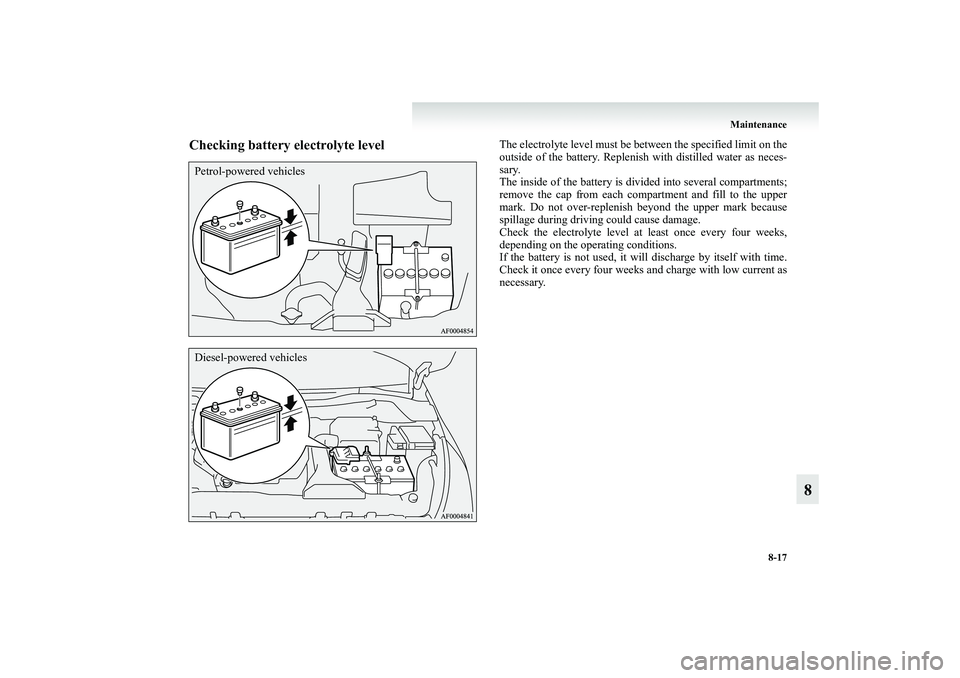
Maintenance
8-17
8
Checking battery electrolyte level
The electrolyte level must be between the specified limit on the
outside of the battery. Replenish with distilled water as neces-
sary.
The inside of the battery is divided into several compartments;
remove the cap from each compartment and fill to the upper
mark. Do not over-replenish beyond the upper mark because
spillage during driving could cause damage.
Check the electrolyte level at least once every four weeks,
depending on the operating conditions.
If the battery is not used, it will discharge by itself with time.
Check it once every four weeks and charge with low current as
necessary.
Petrol-powered vehiclesDiesel-powered vehicles
BK-XP08E1ENUK.en-uk.book Page 17 Monday, August 13, 2007 2:20 PM
Page 374 of 458
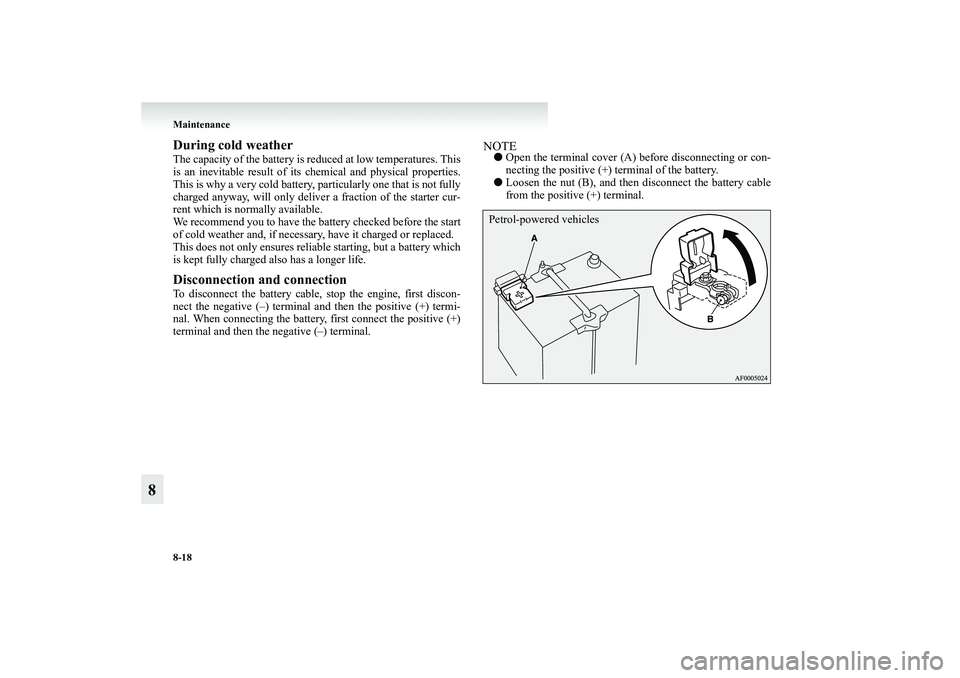
8-18 Maintenance
8
During cold weatherThe capacity of the battery is reduced at low temperatures. This
is an inevitable result of its chemical and physical properties.
This is why a very cold battery, particularly one that is not fully
charged anyway, will only deliver a fraction of the starter cur-
rent which is normally available.
We recommend you to have the battery checked before the start
of cold weather and, if necessary, have it charged or replaced.
This does not only ensures reliable starting, but a battery which
is kept fully charged also has a longer life.Disconnection and connectionTo disconnect the battery cable, stop the engine, first discon-
nect the negative (–) terminal and then the positive (+) termi-
nal. When connecting the battery, first connect the positive (+)
terminal and then the negative (–) terminal.
NOTE●Open the terminal cover (A) before disconnecting or con-
necting the positive (+) terminal of the battery.
●Loosen the nut (B), and then disconnect the battery cable
from the positive (+) terminal.Petrol-powered vehicles
BK-XP08E1ENUK.en-uk.book Page 18 Monday, August 13, 2007 2:20 PM
Page 375 of 458
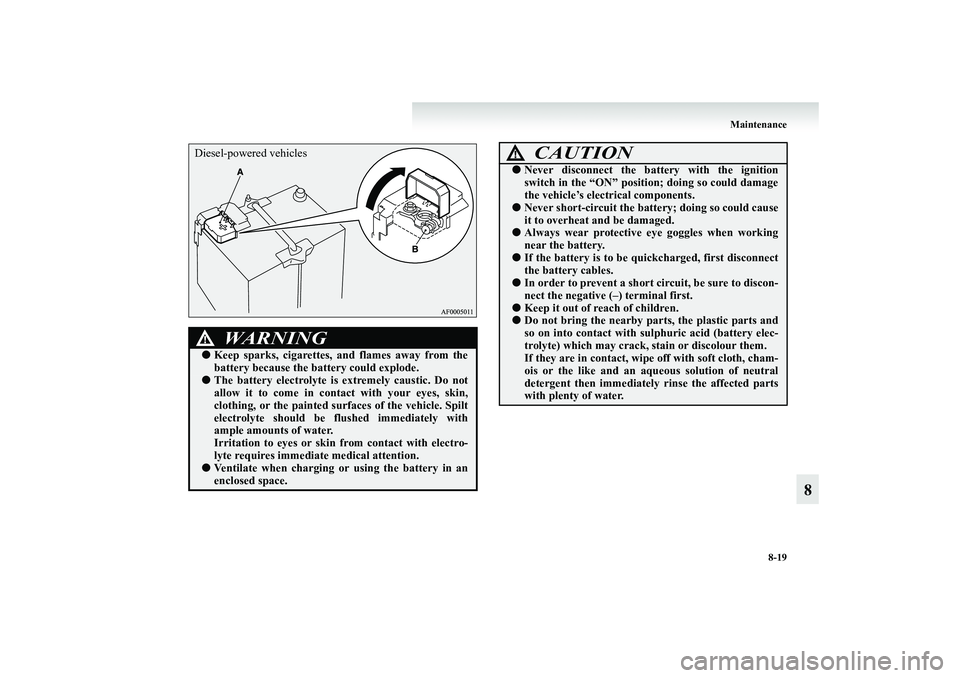
Maintenance
8-19
8
WARNING
!●Keep sparks, cigarettes, and flames away from the
battery because the battery could explode.●The battery electrolyte is extremely caustic. Do not
allow it to come in contact with your eyes, skin,
clothing, or the painted surfaces of the vehicle. Spilt
electrolyte should be flushed immediately with
ample amounts of water.
Irritation to eyes or skin from contact with electro-
lyte requires immediate medical attention.●Ventilate when charging or using the battery in an
enclosed space.Diesel-powered vehicles
CAUTION
!●Never disconnect the battery with the ignition
switch in the “ON” position; doing so could damage
the vehicle’s electrical components.●Never short-circuit the battery; doing so could cause
it to overheat and be damaged.●Always wear protective eye goggles when working
near the battery.●If the battery is to be quickcharged, first disconnect
the battery cables.●In order to prevent a short circuit, be sure to discon-
nect the negative (–) terminal first.●Keep it out of reach of children.●Do not bring the nearby parts, the plastic parts and
so on into contact with sulphuric acid (battery elec-
trolyte) which may crack, stain or discolour them.
If they are in contact, wipe off with soft cloth, cham-
ois or the like and an aqueous solution of neutral
detergent then immediately rinse the affected parts
with plenty of water.
BK-XP08E1ENUK.en-uk.book Page 19 Monday, August 13, 2007 2:20 PM
Page 376 of 458
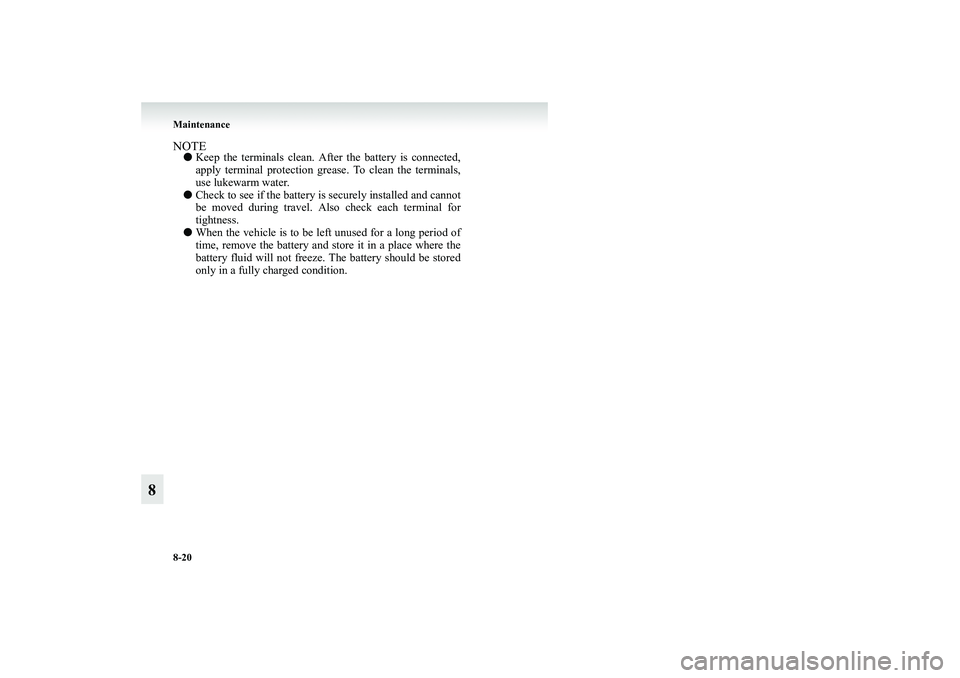
8-20 Maintenance
8
NOTE●Keep the terminals clean. After the battery is connected,
apply terminal protection grease. To clean the terminals,
use lukewarm water.
●Check to see if the battery is securely installed and cannot
be moved during travel. Also check each terminal for
tightness.
●When the vehicle is to be left unused for a long period of
time, remove the battery and store it in a place where the
battery fluid will not freeze. The battery should be stored
only in a fully charged condition.
BK-XP08E1ENUK.en-uk.book Page 20 Monday, August 13, 2007 2:20 PM
Page 377 of 458
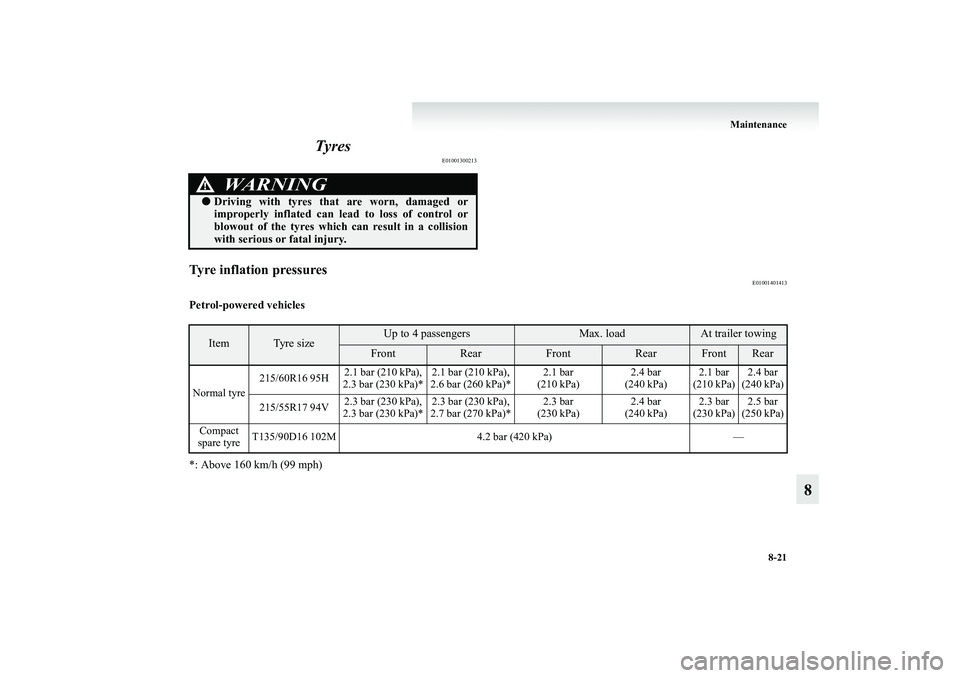
Maintenance
8-21
8 Tyres
E01001300213
Tyre inflation pressures
E01001401413
Petrol-powered vehicles
*: Above 160 km/h (99 mph)
WARNING
!●Driving with tyres that are worn, damaged or
improperly inflated can lead to loss of control or
blowout of the tyres which can result in a collision
with serious or fatal injury.Item
Ty r e s i z e
Up to 4 passengers
Max. load
At trailer towing
Front
Rear
Front
Rear
Front
Rear
Normal tyre215/60R16 95H2.1 bar (210 kPa),
2.3 bar (230 kPa)*2.1 bar (210 kPa),
2.6 bar (260 kPa)*2.1 bar
(210 kPa)2.4 bar
(240 kPa)2.1 bar
(210 kPa)2.4 bar
(240 kPa)
215/55R17 94V2.3 bar (230 kPa),
2.3 bar (230 kPa)*2.3 bar (230 kPa),
2.7 bar (270 kPa)*2.3 bar
(230 kPa)2.4 bar
(240 kPa)2.3 bar
(230 kPa)2.5 bar
(250 kPa)
Compact
spare tyreT135/90D16 102M 4.2 bar (420 kPa) —
BK-XP08E1ENUK.en-uk.book Page 21 Monday, August 13, 2007 2:20 PM
Page 378 of 458
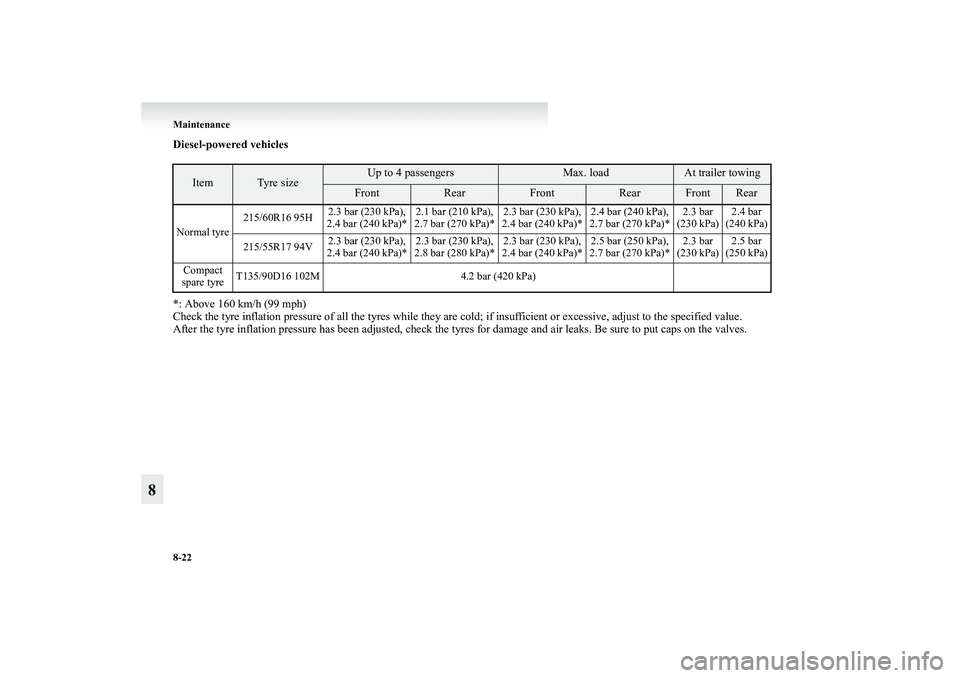
8-22 Maintenance
8
Diesel-powered vehicles
*: Above 160 km/h (99 mph)
Check the tyre inflation pressure of all the tyres while they are cold; if insufficient or excessive, adjust to the specified value.
After the tyre inflation pressure has been adjusted, check the tyres for damage and air leaks. Be sure to put caps on the valves.
Item
Ty r e s i z e
Up to 4 passengers
Max. load
At trailer towing
Front
Rear
Front
Rear
Front
Rear
Normal tyre215/60R16 95H2.3 bar (230 kPa),
2.4 bar (240 kPa)*2.1 bar (210 kPa),
2.7 bar (270 kPa)*2.3 bar (230 kPa),
2.4 bar (240 kPa)*2.4 bar (240 kPa),
2.7 bar (270 kPa)*2.3 bar
(230 kPa)2.4 bar
(240 kPa)
215/55R17 94V2.3 bar (230 kPa),
2.4 bar (240 kPa)*2.3 bar (230 kPa),
2.8 bar (280 kPa)*2.3 bar (230 kPa),
2.4 bar (240 kPa)*2.5 bar (250 kPa),
2.7 bar (270 kPa)*2.3 bar
(230 kPa)2.5 bar
(250 kPa)
Compact
spare tyreT135/90D16 102M 4.2 bar (420 kPa)BK-XP08E1ENUK.en-uk.book Page 22 Monday, August 13, 2007 2:20 PM
Page 379 of 458
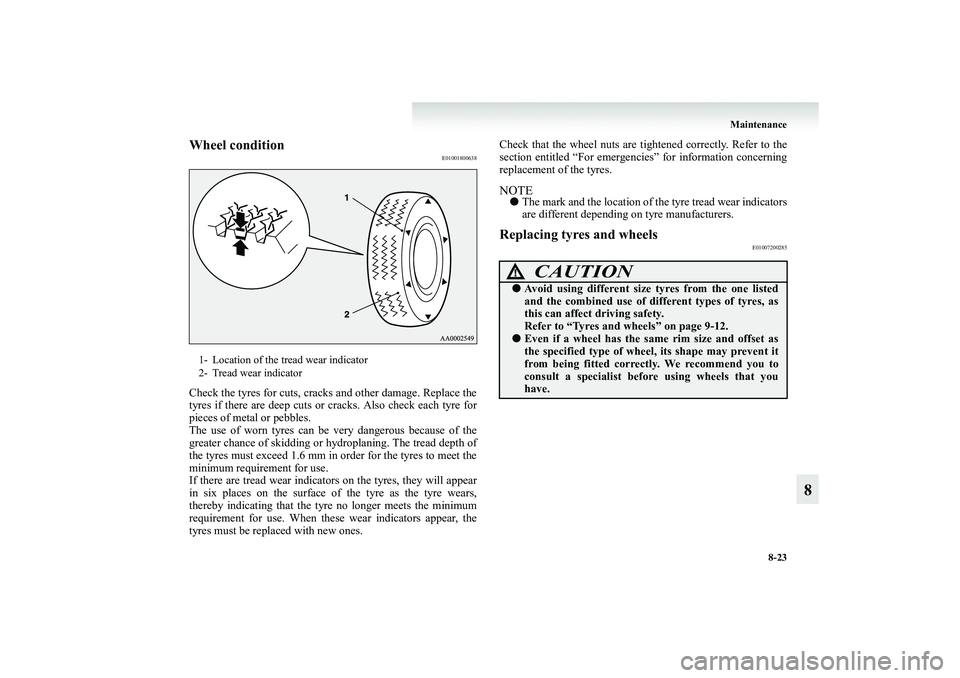
Maintenance
8-23
8
Wheel condition
E01001800638
Check the tyres for cuts, cracks and other damage. Replace the
tyres if there are deep cuts or cracks. Also check each tyre for
pieces of metal or pebbles.
The use of worn tyres can be very dangerous because of the
greater chance of skidding or hydroplaning. The tread depth of
the tyres must exceed 1.6 mm in order for the tyres to meet the
minimum requirement for use.
If there are tread wear indicators on the tyres, they will appear
in six places on the surface of the tyre as the tyre wears,
thereby indicating that the tyre no longer meets the minimum
requirement for use. When these wear indicators appear, the
tyres must be replaced with new ones.Check that the wheel nuts are tightened correctly. Refer to the
section entitled “For emergencies” for information concerning
replacement of the tyres.
NOTE●The mark and the location of the tyre tread wear indicators
are different depending on tyre manufacturers.Replacing tyres and wheels
E01007200285
1- Location of the tread wear indicator
2- Tread wear indicator
CAUTION
!●Avoid using different size tyres from the one listed
and the combined use of different types of tyres, as
this can affect driving safety.
Refer to “Tyres and wheels” on page 9-12.●Even if a wheel has the same rim size and offset as
the specified type of wheel, its shape may prevent it
from being fitted correctly. We recommend you to
consult a specialist before using wheels that you
have.
BK-XP08E1ENUK.en-uk.book Page 23 Monday, August 13, 2007 2:20 PM
Page 380 of 458
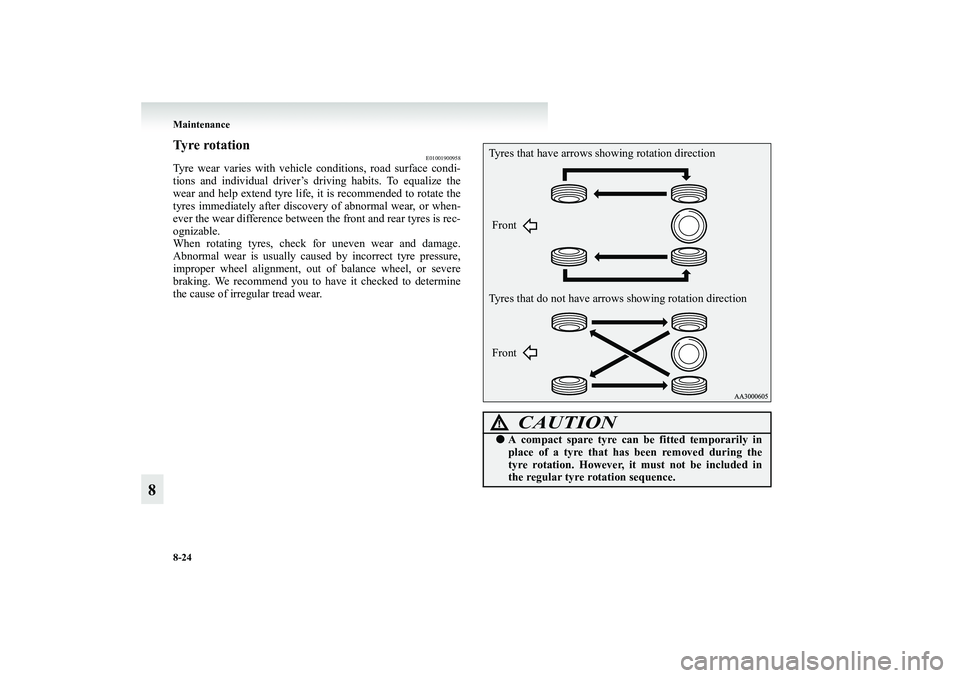
8-24 Maintenance
8
Tyre rotation
E01001900958
Tyre wear varies with vehicle conditions, road surface condi-
tions and individual driver’s driving habits. To equalize the
wear and help extend tyre life, it is recommended to rotate the
tyres immediately after discovery of abnormal wear, or when-
ever the wear difference between the front and rear tyres is rec-
ognizable.
When rotating tyres, check for uneven wear and damage.
Abnormal wear is usually caused by incorrect tyre pressure,
improper wheel alignment, out of balance wheel, or severe
braking. We recommend you to have it checked to determine
the cause of irregular tread wear.
CAUTION
!●A compact spare tyre can be fitted temporarily in
place of a tyre that has been removed during the
tyre rotation. However, it must not be included in
the regular tyre rotation sequence.Tyres that have arrows showing rotation direction
Tyres that do not have arrows showing rotation direction
Front Front
BK-XP08E1ENUK.en-uk.book Page 24 Monday, August 13, 2007 2:20 PM